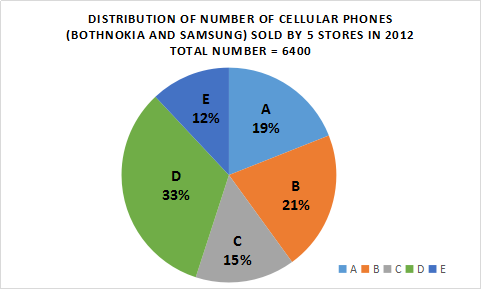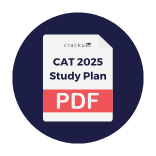IBPS RRB Clerk 12 Sep 2015
Refer to the following pie-charts carefully and answer the given questions.


IBPS RRB Clerk 12 Sep 2015 - Question 131
What is the average number of Samsung cellular phones sold by stores B, C and D?
IBPS RRB Clerk 12 Sep 2015 - Question 132
What is the difference between number of cellular phones (both Nokia and Samsung) sold by store A and total number of Nokia cellular phones sold by stores B and E together?
IBPS RRB Clerk 12 Sep 2015 - Question 133
Number of Samsung cellular phones sold by store E is what percent of the number of phones (both Nokia and Samsung) sold by store C?
For the following questions answer them individually
IBPS RRB Clerk 12 Sep 2015 - Question 134
There are three positive numbers, $${1 \over 3}$$rd of average of all the three numbers is 8 less than the value of the highest number. Average of the lowest and the second lowest number is 8. Which is the highest number?
IBPS RRB Clerk 12 Sep 2015 - Question 135
A sum of money was invested for 14 years was in Scheme A which offers simple interest at a rate of 8% p.a. The amount received from Scheme A after 14 years was then invested for two years in Scheme B which offers compound interest (compounded annually) at a rate of 10% p.a. If the interest received from Scheme B was Rs. 6,678, what was the sum invested in Scheme A?
IBPS RRB Clerk 12 Sep 2015 - Question 136
4 years ago, the respective ratio between $${1 \over 2}$$ of A’s age at that time and four times of B’s age at that time was 5: 12. Eight years hence $${1 \over 2}$$ of A’s age at that time will be less than B’s age at that time by 2 years. What is B’s present age ?
Study the table and answer the given questions –
Data related to salary structure of 5 individuals from different organisations in March.

Note: (i) Total Deduction = Provident Fund Deduction (which is 10% of basic salary) + Other deduction
(ii) Net Salary = Basic Salary + Total Allowance – Total Deduction
(iii) Few values are missing in the table (indicated by -). A candidate is expected to calculate the missing value, if it is required to answer the given question, on the, basis of the given data and information.
IBPS RRB Clerk 12 Sep 2015 - Question 137
If other deduction of P was Rs. 4,720, what was his net salary?
IBPS RRB Clerk 12 Sep 2015 - Question 138
If Q’s total allowance was Rs. 3,000 more than his basic salary, what was his total allowance?
IBPS RRB Clerk 12 Sep 2015 - Question 139
If the respective ratio of Provident Fund deduction and other deduction and other deduction of S was 7 : 13, what was S’s other deduction ?
IBPS RRB Clerk 12 Sep 2015 - Question 140
Basic salary of S is what percent more than the basic salary of R?

